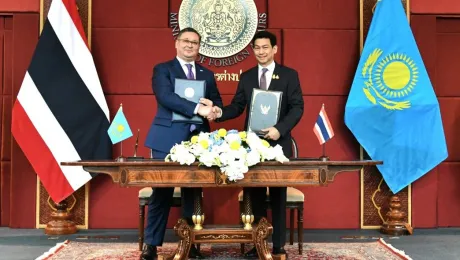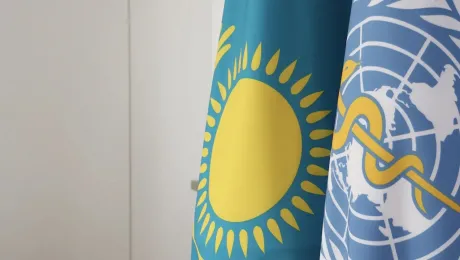The median annual temperature has increased 2°C in the last 75 years with serious droughts now striking twice every five years. As such, Kazakhstan is committed to collective goals to decarbonise the economy and achieve carbon neutrality, Delovoy Kazakhstan reports.
This factsheet outlines the country’s position on climate change and green energy and the country’s initiatives in the sphere of tackling climate change. While Kazakhstan still heavily relies on fossil fuels, the country's leadership is fully focused on low-carbon economic development and is ready to invest significantly in renewable and alternative energy sources.
Kazakhstan’s objectives and position on tackling climate change
Kazakhstan fully recognises the need to transition to a greener future. As such, the government of Kazakhstan has ratified the following Agreements and made the following pledges:
- Kazakhstan signed the Paris Agreement on November 4, 2016. The document entered into force for the country on 6 December 2016. Kazakhstan’s unconditional nationally determined contributions (NDC) target aims to reduce greenhouse gas (GHG) emissions by 15% below 1990 levels by 2030.
- In December 2020, the President of Kazakhstan, Kassym-Jomart Tokayev, made a commitment to achieve full decarbonisation of Kazakhstan’s economy by 2060. Tokayev also instructed the government to bring the share of renewable energy in the nation’s total energy grid to 15 percent by 2030.
- Currently, the Doctrine for achieving carbon neutrality of Kazakhstan until 2060 is being developed. It will present a long-term vision for the transition to low greenhouse gas emissions and the necessary transformations in all sectors of the economy. These include abandonment of new coal-fired generation projects and phasing out of coal combustion by 2025, planting two billion trees by 2025, doubling renewable energy sources in total energy balance by 2030; 100 percent sorting of municipal solid waste by 2040, the introduction of green hydrogen, among other goals.
- Guided by the Sustainable Development Goals (SDG), Kazakhstan included sustainable and green economy goals among its priorities in its Strategy-2050 national development plan.
- The 'National Development Plan by 2025', released in March 2021, highlights the development of green technologies and increasing renewable energies.
Kazakhstan’s initiatives in the sphere of tackling climate change
To achieve the objectives set out above, the country has taken the following initiatives:
- In February 2021, President Tokayev instructed to map out a new law on the issues of alternative energy development. The law should incorporate the approaches and norms of regulation of both renewable and alternative energy sources.
- July 1, 2021, marked the official rollout of Kazakhstan’s new environmental legislation – initially signed into law by President Tokayev in January of this year. The code will promote biodiversity, establish tariffs to encourage renewable energy source (RES) development, and implement emissions caps for Kazakhstan’s top 50 carbon emitters.
- So far, around 2000 megawatt of renewables have been commissioned and Kazakhstan is well underway to reaching a 15 percent share of renewables in energy generation by 2030.
- Green financing has been a priority of the Astana International Financial Centre (AIFC) as evidenced by the organisation’s Green Financial Centre (GFC), created on June 1, 2018, with the aim of developing and promoting green finance in Kazakhstan and the Central Asian region.
- Kazakhstan boasts competitive, large-scale wind and solar irradiation potential (roughly 50% of the country’s territory has average wind speeds of 4 to 6 meters per second - suitable for energy generation).
- The German-Swedish firm Svevind Energy announced in June that it was working with Kazakh Invest on the world’s largest green hydrogen complex, powered by 45 GW of wind and solar energy installed in Kazakhstan. In October, the road map for the implementation of the project was signed at the meeting with the President of SVEVIND Wolfgang Kropp, organised during the visit of the Kazakh delegation to Sweden.
- Italy’s Eni is also in talks with KazMunaiGas to develop hydrogen capacity, having already built a combined 150 MW of renewable energy capacity spread across two wind farms and a PV plant in the country.
- The construction of the Zhanatas 100 MW wind farm in southern Kazakhstan will be one of the largest windfarms in the region.
- First President Nursultan Nazarbayev initiated in 2010 the Green Bridge Partnership Program to promote the transfer of cutting-edge technologies, knowledge sharing, and financial support to create sustainable economies and create new and long-term green jobs.
- Starting from 2021, the country will plant two billion trees in the next five years to increase carbon absorption and curb looming desertification problems as a result of climate change.
Recent achievements in tackling climate change
- In a space of six years, Kazakhstan has increased its renewable energy capacity sixfold, to 1,650 megawatts in 2020.
- Last year, 25 items of renewable energy infrastructure were launched, mainly wind and solar power plants, adding 600 megawatts of capacity. The goal for 2021 is 23 more projects and an additional 400 megawatts.
- Since the beginning of 2011, the number of renewable energy facilities in Kazakhstan has grown from 23 to 111.
- In 2017, Kazakhstan hosted EXPO 2017, themed ‘future energy’. The event attracted more than 130 countries and nearly 4 million visitors.
- The government established the International Centre for the development of green technologies, located in the Expo 2017 facilities. Its function is to build a culture of green societies and address environmental issues through the development of green technologies in Kazakhstan.
- The Government of Kazakhstan added over 1,000 megawatts of renewable energy projects in Kazakhstan through competitive auctions, where private companies offer to build and operate plants and sell the electricity at low cost, all of which ranged between 25-40 percent below the prevailing tariffs.
- According to a 2021 PwC report, in comparison with peers in the CIS, Kazakhstan stands out as a country achieving its goals for developing the renewable energy sector and setting ambitious targets for transitioning to a green economy.
- Kazakhstan has been ranked 33rd out of 76 in the Green Future Index that evaluates countries’ commitment to a low carbon future.
- Kazakhstan has been committed to the revival of the Aral Sea. Thanks to the taken measures, the northern section of the sea is no longer shrinking but expanding.
- Mirjana Spoljaric Egger, United Nations Assistant Secretary-General and UNDP’s Regional Director for Europe and the CIS, welcomed Kazakhstan’s Carbon Neutral Development until 2060 strategy saying that the country shows political will and the vision to lead the way. She noted that Kazakhstan has consistently demonstrated its commitment to the development of a decarbonised economy.







